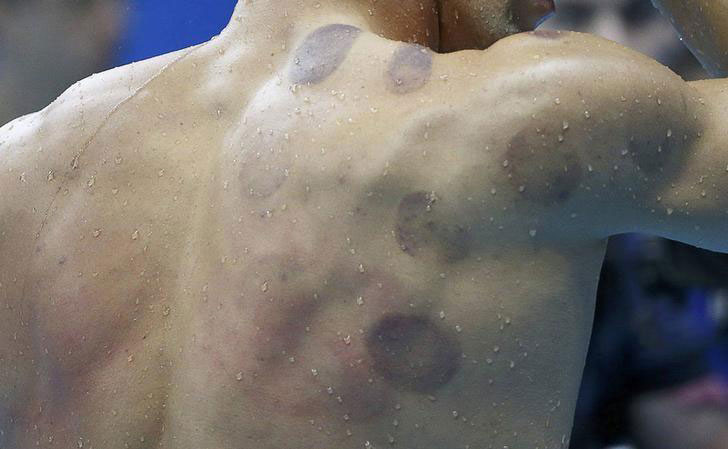Can Cupping Help with Muscle Pain?

Image courtesy of Reuters
People turn to cupping to relax their muscles and reduce pain, particularly in the neck or back, and some athletes say it helps with sports-related pain.
Many people saw the big purple bruises on gold-medalist swimmer Michael Phelps during the Summer Olympics and became curious about cupping. Phelps is such a fan he posted a photo of himself getting cupped on Instagram.
In the United States, people turn to cupping to relax their muscles and reduce pain, particularly in the neck or back, and some athletes say it helps with sports-related pain.
The practice goes back to ancient Greece and Egypt and is now most common in China, where it is used for many conditions that might benefit from an increase in blood flow. According to an overview of the research, largely from China, cupping may be helpful to boost acupuncture or medication to treat acne, facial paralysis, shingles, and arthritis in your neck. The strongest evidence applies to neck pain.
YOU MIGHT ALSO LIKE: Tell Your Doctor What You’re Doing to Manage Pain
How cupping works
Your therapist will put a flammable substance — alcohol, herbs, or paper — in a cup and set it on fire. Once the fire is dying, she’ll put the cup upside down on your skin, where it sits for up to three minutes. The air inside the cup cools, creating a vacuum. Your blood vessels expand, creating the bruise. You can see a video of a “fire” cupping below:
Another option is to use a rubber pump to create a vacuum. If the therapist uses silicone cups, he or she can move them from one spot to another on your skin.
In “wet” cupping, the liquid is your blood. The therapist puts the cup on your skin for three minutes, then removes the cup and makes light cuts on your skin with a scalpel. A second suction draws out your blood.
Obviously, you’re risking infection. If you try this, ask the therapist how he or she ensures cleanliness, and be sure that he or she applies some antibiotic and a bandage to each bruise afterwards. You can see an example of “wet” cupping below:
In “needle cupping,” the therapist puts cups over acupuncture needles inserted into your skin.
Whatever method you choose, the therapist should use no more than seven cups in a session. The bruises last from three to 10 days.
Can cupping help your pain?
The science about cupping focuses on chronic neck pain, a common problem. One study compared the effects of cupping and a relaxation exercise on 61 middle-aged volunteers with chronic neck pain. Half of the volunteers received a cupping treatment twice a week for 12 weeks. The others did the relaxation exercise.
Both groups reported less pain overall at the end of the study, but the people who received the cupping reported more of a mood boost and felt less pain when their necks were pressed.
YOU MIGHT ALSO LIKE: Health Benefits of Massage
In another study, researchers implanted a microdialysis system on both sides of the trapezius muscle in 12 volunteers, half of whom had chronic neck pain. The system detected levels of lactate, pyruvate, glucose, and glycerin in the muscle. The researchers also measured the pain thresholds for the volunteers, either in their feet if they had neck pain, or near the neck in the healthy group. The cuppings occurred on only one side of the neck.
The results: Beginning two hours and 40 minutes after a cupping, the muscle experienced chemical changes that usually come from intense physical exercise. Pain thresholds increased in the neck pain patients immediately after the cupping, but the effect was gone by the end of 4.5 hours.
It makes sense that athletes would like a practice that gives them immediate pain relief and then makes a muscle feel exercised.
Some people hope that a series of cuppings will help a chronic pain lessen over time. A study followed volunteers for two years after they had received cupping for neck pain. Overall, they didn’t report less pain, but they did have more mobility in their necks.
Sixteen of 82 patients said the cupping kept their neck pain below the threshold it was before, for around 9 months on average. That said, they knew they’d received a treatment, so the placebo effect could explain their pain relief.
To be sure the treatment is more than a placebo, you would need a “blind” study comparing a group receiving a treatment and a group that received a placebo, with no participants knowing who was receiving which treatment. In the study, the researchers noted that most of the patients didn’t choose to have more cupping therapy.
The study measuring pain thresholds also wasn’t blinded, so, again, the measurement may reflect the placebo effect.
Is cupping worth doing?
As long as you’re not spending too much or risking infection, something safe that makes you feel better isn’t necessarily a mistake. Pain is very much about perception, and we all have ways to “psych” ourselves into desired frames of mind.
YOU MIGHT ALSO LIKE: Homeopathic and Herbal Remedies Are Still Controversial
Updated:
July 13, 2023
Reviewed By:
Janet O’Dell, RN